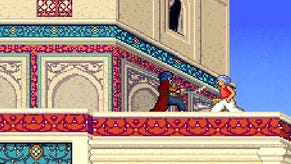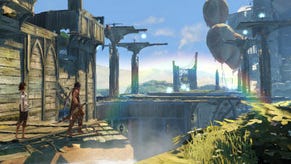Wot I Think: Prince Of Persia
The latest reinvention of Ubisoft's Prince of Persia was out on PC on Friday, a week after the console release, and with rumours of (the shop version) containing no DRM. Having played the PC version all the way through, here's Wot I Think.
Lipstick on a pig, to borrow this year’s favourite insult, would be slightly too cruel a phrase to apply to the latest reinvention of the Prince of Persia series. It’s more of an oil painting on a donkey. An astonishingly beautiful game, which fluctuates between banal and frustrating, occasionally kicking you in the face.
Much appears traditional. You have a large world of walls and beams to bounce around, and baddies to fight. But not all is familiar. The previous trilogy of PoP introduced a stunning new way to play a platform game. The Dagger of Time allowed the Prince to undo his acrobatic mistakes by rewinding time. It was a revelation, reinventing the reliance on checkpoints and quicksaves. Now the big red reset button has been pressed once again, it’s all gone. It's replaced by an NPC buddy, Elika.
Elika is a princess of a land ravaged by the Corruption – a malevolent, pulsating disease turning the formerly beautiful world into something morbid and dying. Her father has chopped down a tree and unleashed a terrible god. Together, for some reason, you need to leap and fight through the game’s twenty regions, repeatedly defeating four of its bosses, and finally attempt to restore the Tree of Life. This is mostly achieved by using Elika’s magics to reverse the Corruption and restore the pretties... No one mention Zelda: The Twilight Princess – it might get awkward.
The Prince is awkwardly forced to rely on Elika, whose apparent ability to fly means she can boost him slightly further than the limits of his jumps, and rescue him when he falls, putting him back on the last flat platform. The result is a peculiarly artificial interdependence between them, in a world designed to reach just beyond the Prince's abilities. However, for reasons unfathomable, Elika needs to be given a piggyback when climbing ivy, and requires help being hauled up to some ledges, despite being able to fly. Unfortunately, this doesn’t come close to replacing the majestic time manipulation in a way that’s a fifth as satisfying. It's simply an elaborate "loading" screen, as she swoops in and dumps you to the checkpoint. Which is fine - preferable over tortuous replaying of large sections - but they used to have something so much better.
After you’ve de-corrupted an area, you then run around it all over again collecting Light Seeds. Enough of these seeds will unlock a new power for Elika back at the Temple, which means you can use a new coloured “plate”. These are pods on the walls that when used will send the Prince charging through the air, or along Sonic-like pathways, dodging obstacles. These range between automatic, where the game flies you to the next area, to maddening, where you're asked to psychically dodge objects or be reset to the very beginning of the arcade sequence.
But there are two other changes that are more significant. The first is the combat. The previous trilogy always struggled with this, spoiling the fantastic acrobatic sequences by making you slog your way through repetitive encounters. It’s demoralising to realise how little was learned. The combat is now utterly monstrous. The majority of your fights will be against the same four bosses, over and over and over, and each is more like Mortal Kombat than a third-person action game. Using combos and a variety of attacks (sword, claw hand, and Elika), the aim is more often to get the enemy to the edge of the arena than to kill them. A bit like Bloodsports. Early on it’s far easier just to ignore combos and hammer the sword attack. Once the fights get too tough for that, it becomes so infuriatingly fiddly that combos become almost impossible as you're incessantly blocked, and you’re left to picking bits of health off here and there. Should you be about to die, Elika will rescue you, and your opponent will regain some of his health bar. Each encounter has your heart sink. And this is made far worse by almost never getting to kill the enemies, but instead watch them slink off for the next fight.
The second change is the nature of how you move around the world. Sands of Time’s fantastic puzzling exploration of the environment is almost entirely abandoned, replaced with a game that’s about a linear series of non-optional quick-time events. Except very intermittent. Slow-time events, if you will. You spend almost as much time wall-running as you do on the ground, and it’s about pressing the corresponding button as you auto-run past the right object. You don't even need to hold 'forward' while running, so automated is the whole design. This is all extremely elementary, and because you can approach the twenty sections in any order you wish, there’s no increase in the acrobatic challenge as you progress, but for the introduction of some annoying blobs on the walls. You're on level 1 for the entire game.
The Prince is equipped with a metal claw on one hand that lets him haul himself higher on walls, or grind down them (think fingernails and blackboards: the game!), and even - somehow - allows him to temporarily run upside down. But again, this isn't a tool you can use to improvise routes through the adventure playgrounds. It's the only option you have to make your way along the single prescribed corridor. The beautiful corridor, with the swift, detailed animations, that looks simply stunning. But the corridor.
Despite resetting you when you fall, Elika is too often a burden. She slows you down with her mad piggybacking, and maddeningly will shove you out the way halfway through a move. Swinging from pole to pole occasionally lets you enjoy the fluidity of the movement, until she tries to land exactly where you already were, and pushes you into a wall. She'll also occasionally knock into you while you're getting ready to jump, resetting the animation, and breaking your flow.
The result is something that's clearly going to appeal to some, and infuriate others (hello!). If you want that illusion of choice that defined Sands of Time, using your abilities to discover the correct route to scale a room, you'll be enormously disappointed. If you want a feeling of almost flying through levels, embracing the culture of QTE to an almost music-rhythm game level, then the standard movement will appeal.
Sadly the story fails to engage, which wouldn't be a problem were it not for the enormous numbers of interrupting cutscenes. The heavy-handed suggestions that Elika has a dark secret are as beleaguering as the Prince’s unskippable dickish comments throughout. We get it, he’s a dick. And unfortunately, this builds up to an ending so aggravating that you'll wonder if the game was an elaborate joke played on you. So while the graphics are never less than breathtaking, and the score is beautiful, it all feels rather despondent.
It’s undeniably one of the most visually stunning games ever. The art is spectacular. The game is by no means a disaster. But when your predecessor was so lovely (although certainly with its flaws), the comparison is going to make you look worse than perhaps you are. This is a game that has forgotten what made Sands of Time so entertaining and interesting, replacing the fun of solving a room with a corridor-like inevitability throughout. And somehow makes the combat worse. It’s big, and it’s functional, it's too often annoying, and despite the care that’s gone into the presentation, the passion is gone.
















